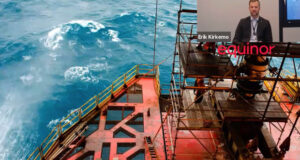Strong safety culture can help companies better identify, mitigate well control risk
By Stephen Whitfield, Associate Editor
Avoiding major accidents is always top of mind for any operator, and having an effective approach to well control is one of the most important safeguards in maintaining safe operations on their rigs. Equinor is no different. Erik Kirkemo, Senior Vice President of Drilling and Wells, said his company is focused on establishing a culture that encourages open discussion of well control concerns and a proactive approach to preventing future incidents.
“Major accident risk is the top priority of our safety agenda,” Mr Kirkemo said. “That entails a focus on the management of well control risks in any relevant setting and our proactive work on prevention. We must continue to strengthen our work.”
During his keynote address at the virtually held 2020 IADC International Well Control Conference on 14 October, Mr Kirkemo outlined Equinor’s approach to well control incident prevention. Through its “One Team” organizational structure, Equinor has promoted an open, collaborative environment where personnel are encouraged to speak freely about well control concerns. Collaboration is critical to managing well control risk: Mr Kirkemo noted that Equinor prioritizes collaboration with suppliers and drilling contractors on establishing a consistent strategy for addressing well control risk. The company also encourages openness in communication through well control forums, where rig crews and other personnel can discuss case histories and the practicalities of various prevention methods.

Incident prevention starts from the beginning of a well’s lifecycle. This means that it’s important to understand well control risks and incorporate that understanding into the design of the well, Mr Kirkemo said. In addition, everyone involved in a drilling operation should be aware of the barriers that mitigate the risk of a major scale accident. Such barriers fall into three groups: technical, organizational and operational.
Technical barriers center around the installation of systems and equipment, like BOPs, packers and plugs, as well as new technologies that could make incident mitigation easier. Mr Kirkemo noted Equinor’s Automated Drilling Control app, which allows for autonomous monitoring of drilling fluid, leakage, mud weight measurement and early kick and loss detection.
“Digitization in well control is a very important topic,” he noted. “We have been working on it for quite some time. Our Automated Drilling Control system provides an easy user interface and support functions for early intervention and better understanding of well control. I think there’s a huge opportunity in digital, and we’ve only scratched the surface of it so far.”
Organizational barriers include the steering documentation that outlines procedures for detecting and mitigating well control issues, and operational barriers refer to competencies of the personnel in following those procedures. These barriers go hand in hand with developing a strong safety culture, Mr Kirkemo said.
In recent years, Equinor has placed a greater emphasis on developing competencies. It established a group of well control and well integrity subject matter experts who work closely with its operations personnel through task forces and emergency response support. The company also offers a two-day “Safety in Design” course that illustrates the ways in which errors in planning or design can lead to major scale accidents. It holds an annual well integrity seminar in which personnel learn about various case studies.
Mr Kirkemo described safety culture as a top-down enterprise, and that it is essential for leadership to model the behaviors and adherence to protocol.
“I want to be a role model within safety leadership. From a leadership perspective, what I do is much more important than what I say, so I need to always adhere to the safety standards,” he said. “I need to ensure precision in managing the risks associated with well control and well integrity, as well as managing the measures we put in place to prevent them from occurring.”




